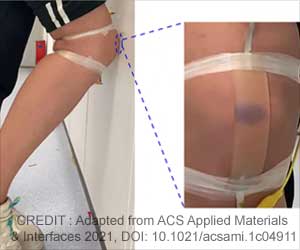Robots and prosthetic limbs don’t have these warning signs, which could lead to further injury.
‘Ionic skins (I-skin) responds like a human skin in terms of electrical and optical signaling. This brings about new opportunities for detecting damage in robots and prosthetic devices.’
Now, researchers reporting in ACS Applied Materials & Interfaces have developed an artificial skin that senses force through ionic signals and also changes color from yellow to a bruise-like purple, providing a visual cue that damage has occurred.
Scientists have developed many different types of electronic skins, or e-skins, that can sense stimuli through electron transmission. However, these electrical conductors are not always biocompatible, which could limit their use in some types of prosthetics.
In contrast, ionic skins, or I-skins, use ions as charge carriers, similar to human skin. These ionically conductive hydrogels have superior transparency, stretchability and biocompatibility compared with e-skins.
Qi Zhang, Shiping Zhu and colleagues wanted to develop an I-skin that, in addition to registering changes in electrical signal with an applied force, could also change color to mimic human bruising.
The researchers made an ionic organohydrogel that contained a molecule, called spiropyran, that changes color from pale yellow to bluish-purple under mechanical stress.
In testing, the gel showed changes in color and electrical conductivity when stretched or compressed, and the purple color remained for 2-5 hours before fading back to yellow.
Then, the team taped the I-skin to different body parts of volunteers, such as the finger, hand and knee.
Bending or stretching caused a change in the electrical signal but not bruising, just like human skin. However, forceful and repeated pressing, hitting and pinching produced a color change.
The I-skin, which responds like human skin in terms of electrical and optical signaling, opens up new opportunities for detecting damage in prosthetic devices and robotics, the researchers say.
Source: Eurekalert



